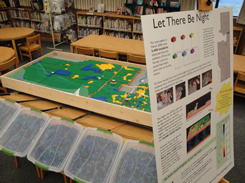 3D Model Visits School
3D Model Visits School
Students built a model of the results of the Let There Be Night experiment using over 35,000 LEGO blocks to represent the ideal night sky. From that 3D map, over 12,000 blocks had to be removed to represent the night sky lost to light pollution, according to over 3,400 student observations. The 3D model is displayed at Madison Elementary School on January 25-29, 2010.
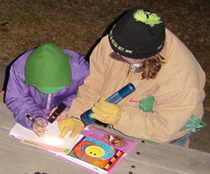
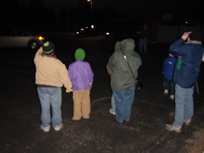 Taking Readings on a Cold, Windy Night
Taking Readings on a Cold, Windy Night
Members of Madison's SLT gathered in the cold to record their SQM values and look through a telescope at some celestial highlights. Venus appeard as a thin crescent, Saturn had two visible moons and its ring, and the Orion Nebula was a bright fuzzy spot with lots of stars. Then they were off to the pavillion to take SQM readings.
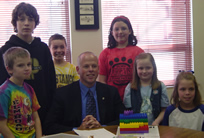 Meeting with Mayor Rea
Meeting with Mayor Rea
Madison student Lauren M. and others meet with Mishawaka Mayor Jeff Rea to discuss Let There Be Night, outdoor lighting issues, and Earth Hour, occurring March 28th. See the related WNDU TV story.
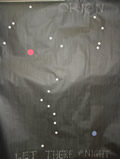 Readying for the Hunt
Readying for the Hunt
Madison Elementary School is getting ready for Let There Be Night and the hunt for stars in Orion. The large starfield displayed in school emphasizes the red star Betelgeuse and the blue star Rigel. Image, left, courtesy of Lisa Soto Kile.
Ms. Sommers writes, "Our Science Fair was earlier this month, and each classroom was supposed to work on a class project to introduce the kids to the scientific process. The 3rd graders did work on observing Orion between mid-January and early February. I geared the kids towards this just so that they can get used to looking for Orion in the night sky and figuring out what magnitude they were looking at using the magnitude chart. Basically the driving question was whether or not the magnitudes would change much from house to house out here in Madison Township. To try to keep the variables to a minimum, I had the kids observe Orion at 7:30 p.m. (not too late...but late enough that they were able to see it.)
It was interesting because their thinking changed and the whole idea of unnecessary outdoor lighting was discussed quite extensively--there were a few students who got quite a few high magnitude readings, so we talked in class about whether or not they had any outdoor lights and whether they had neighbors nearby."
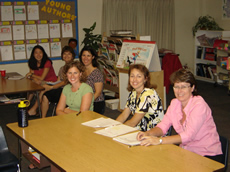 Madison Teachers Have Key Role
Madison Teachers Have Key Role
On September 25, 2008, Madison teachers prepare for LTBN at the first of two in-service sessions. The support of teachers is paramount to the success of this community-wide science experiment.
Meanwhile, different but related...
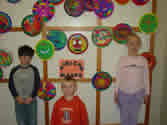 Madison students created masks for Lisa Soto Kile's African Masks activity on Paper Plate Education.
Madison students created masks for Lisa Soto Kile's African Masks activity on Paper Plate Education.
See http://analyzer.depaul.edu/paperplate/mask.htm.
